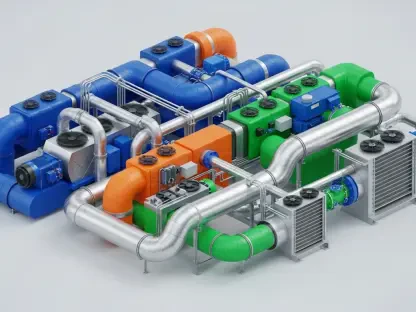Setting the Stage for a Defense Revolution
Imagine a nation historically dependent on foreign arms transforming into a key supplier of military might to nearly 100 countries. This is the reality of India’s defense sector today, driven by the ambitious “Atmanirbhar Bharat” (Self-Reliant India) initiative. With defense exports soaring 35-fold over the past decade to ₹23,622 crore in the current fiscal year, and production tripling to over ₹1.5 lakh crore, India is positioning itself as a formidable player in the global defense market. This market analysis explores the trends, data, and projections behind this seismic shift, assessing whether India can truly emerge as a powerhouse in defense exports. The significance of this transformation extends beyond national borders, impacting global trade dynamics and geopolitical alignments in a highly competitive industry.
Diving into Market Trends and Growth Trajectories
Explosive Growth in Production and Exports
India’s defense sector has witnessed unprecedented growth, reshaping its standing in the global market. Domestic production has surged to over ₹1.5 lakh crore annually, with projections targeting nearly ₹2 lakh crore in the near term. Exports have climbed dramatically, reaching ₹23,622 crore this year and spanning nearly 100 countries, with ambitious goals set at ₹30,000 crore for the current year and ₹50,000 crore by 2029. This growth reflects a strategic pivot from being one of the world’s largest importers to a credible exporter, driven by a focus on indigenous manufacturing and expanding international demand for cost-effective, reliable military solutions.
Policy Reforms as Market Catalysts
Underpinning this expansion are robust policy reforms that have redefined the defense market landscape in India. The defense budget stands at ₹6.22 lakh crore, with 75% of procurement reserved for local companies, creating a favorable environment for domestic players. Foreign Direct Investment (FDI) limits have been relaxed to 74% under the automatic route and up to 100% with government approval, attracting international capital and expertise. These measures have spurred landmark deals, such as the ₹66,000 crore order for 97 Tejas fighter aircraft to Hindustan Aeronautics Ltd (HAL), signaling strong market confidence in India’s capabilities, though bureaucratic inefficiencies remain a hurdle to sustained momentum.
Strategic Alliances and Technological Advancements
India’s market strategy balances self-reliance with global partnerships, creating a hybrid model that enhances its competitive edge. Collaborations with industry giants like France’s Safran for next-generation fighter jet engines and Airbus with Tata Aerospace for C295 transport aircraft production highlight a blend of foreign technology and local manufacturing. Simultaneously, plans for fifth-generation fighter aircraft and indigenous engine development point to a long-term vision of technological sovereignty. This dual approach positions India as an attractive partner in the global defense supply chain, though scaling indigenous innovation to match international standards remains a critical challenge.
Leveraging Regional and Demographic Strengths
Beyond policies and partnerships, India’s defense market benefits from unique regional and demographic advantages that set it apart. Defense industrial corridors in states like Uttar Pradesh and Tamil Nadu are emerging as manufacturing hubs, fostering localized ecosystems for production and innovation. Additionally, with 65% of its population under 35, India possesses a youthful, skilled workforce capable of driving technological and industrial advancements. These factors, combined with its status as the world’s fastest-growing major economy, create a compelling case for investors, provided infrastructure gaps and skill development are addressed to sustain this market edge.
Forecasting Future Market Dynamics
Emerging Technologies and Global Opportunities
Looking ahead, the trajectory of India’s defense export market will hinge on its ability to adapt to emerging technologies and geopolitical shifts. Areas such as artificial intelligence, drone technology, and cybersecurity are becoming central to modern warfare, necessitating significant investment in research and development. India’s economic strength as the fourth-largest global economy provides the financial capacity to support such innovation, but regulatory unpredictability could deter foreign stakeholders. Navigating these challenges while capitalizing on growing demand for advanced military solutions will be key to securing a larger market share.
Geopolitical Positioning and Export Targets
Geopolitically, India’s non-aggressive stance and emphasis on mutual respect in international relations position it as a trusted defense supplier amid shifting global alliances. Aligning with like-minded nations while expanding export markets offers a strategic advantage, particularly as traditional defense trade dynamics face disruption. Achieving the projected export target of ₹50,000 crore by 2029 could redefine India’s role in the industry, provided it overcomes barriers such as international sanctions and complex trade regulations. This forecast underscores the potential for India to emerge as a disruptor in a market long dominated by a few key players.
Competitive Landscape and Market Risks
The global defense market remains highly competitive, with established giants like the United States, Russia, and China holding significant sway. India’s entry as a cost-competitive manufacturer offers a unique value proposition, but risks such as over-reliance on foreign technology for critical components and delays in domestic R&D could hinder progress. Comparing India’s approach to nations like Israel, which thrives on focused innovation, highlights the need for streamlined processes and targeted investments. Mitigating these risks will determine whether India can sustain its upward trajectory and carve out a lasting niche.
Reflecting on Insights and Strategic Pathways
Looking back, the analysis reveals that India’s defense sector has undergone a remarkable transformation, fueled by exponential growth in production and exports, alongside supportive policies and strategic alliances. The market data paints a picture of a nation on the cusp of global prominence, with regional strengths and demographic advantages adding depth to its potential. Key implications from this journey point to the necessity of addressing bureaucratic delays and technological gaps to maintain momentum. Moving forward, actionable steps include streamlining regulatory frameworks to boost private sector participation, accelerating indigenous innovation through public-private partnerships, and investing in workforce skills for emerging technologies. Additionally, leveraging defense corridors for scalable manufacturing could position India as a cost-effective hub for global buyers. These strategies, if pursued diligently, offer a roadmap for not only meeting export targets but also redefining India’s role in the international defense arena with a vision of collaboration and strength.









